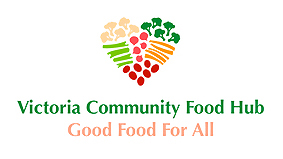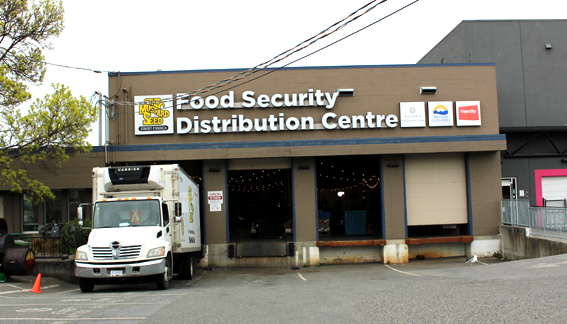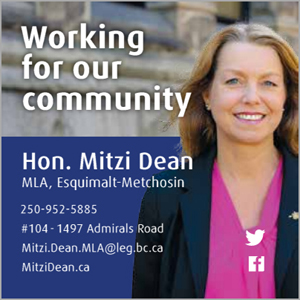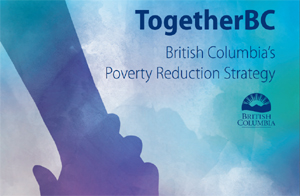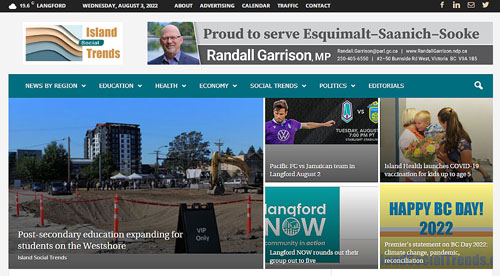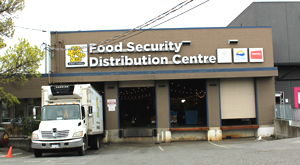
Monday August 8, 2022 | VICTORIA, BC
by Mary P Brooke, B.Sc. | Island Social Trends
Residents dealing with the increasing cost of living in Greater Victoria are benefiting by the work of local food hubs which aim for efficient access to local produce, for processing and delivery of nutritious food products where needed most.
An overall approach looks at the food system broadly, toward enhancing food security in this region. Key components include reduction of food waste and distribution of food products to targeted areas of need. And along the way many people are getting skills training in food production. Local farms get access to processing facility space.

Between 8,000 and 12,000 lb of food are rescued per day through the Food Security Distribution Centre located near the core downtown area of Greater Victoria.
Trucks are on the road five days a week rescuing from several grocery partners including Costco and Fairway Markets, Whole Foods, and Walmart. The so-called ‘rescue food’ is otherwise destined for the Hartland Landfill.
Food is distributed to over 65 agencies including Indigenous communities, school food programs, lunch programs, and seniors programs.
$350,000 grant:
The Victoria Community Food Hub Society’s Food Connections project has received a provincial grant of $350,000, administered through the Victoria Foundation’s Food Security Provincial Initiatives Fund.
To celebrate that grant, the Capital Region Food Hub / Victoria Community Food Hub hosted a tour back on May 12 at the Food Security Distribution Centre at 808 Viewfield Road in Esquimalt.
Popham & Simons took a tour:
Featured speakers at that event were Agriculture and Food Minister Lana Popham and Nicholas Simons, Minister of Social Development and Poverty Reduction. They toured the kitchen, processing and storage areas and addressed media.
Victoria Community Food Hub:
The Victoria Community Food Hub Society (VCFHS) was incorporated as a Charity in 2013. It works hand in hand with its key partners the Capital Region Food and Agriculture Initiatives Roundtable (CRFAIR) and the Foodshare Network to promote a healthy and sustainable food system in the Capital Region.
The VCFHS efforts are focused on ensuring that this food system provides healthy food to the most vulnerable people in our community and works to increase their resources, food skills and social connections for a healthier future.
Business opportunities & food security:
“BC food hubs create new opportunities for small- and medium-sized businesses and strengthen food security so British Columbians can rely on locally grown and processed food now and for generations to come,” said Popham.
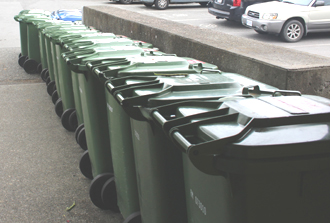
“Our BC Food Hub Network is a wonderful example of innovation at a local level, creating jobs and supporting farming, skills training and community building in the regions they operate,” she said.
Minister Popham had earlier announced (back o March 2) up to $2 million to purchase food-processing equipment and other startup costs for three hubs in Victoria, Cowichan Valley and Bowser in partnership with the City of Victoria, the Victoria Community Food Hub Society, Cowichan Valley Regional District, Cowichan Green Community Society and Vancouver Island University.
The hubs will help small- and medium-scaled businesses access shared food and beverage processing space and equipment to increase their production and sales.
Food Connections:
Food Connections is a program that links locally produced food and food recovered from regional grocery stores to a certified kitchen to create value-added products. Shelf-stable food is then developed for community programs, markets and schools.
During the pandemic there was increased demand for food support in the Greater Victoria area, including through school districts that supported families during the economic disruptions of 2020.
Addressing food insecurity:
“It is unacceptable that more than half a million British Columbians experience household food insecurity,” said Minister Simons. “We are working with community partners to help those in need get nutritious food.”
The funding will support the purchase of food-processing equipment for Food Connections to extend the life of local food and decrease food waste.
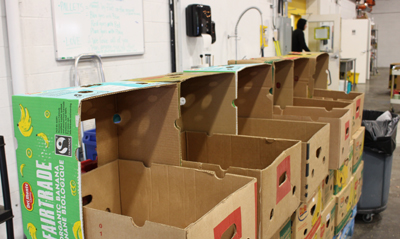
Collecting food that would otherwise be discarded by local grocery stores — i.e. ‘rescue food’ — is part of the food hub program. It speaks to recognizing how the commercialized food supply system has had shortfalls that have led to the waste of edible produce and other food products.
Training for challenged employment sectors:
The equipment will play a vital role in Food Connections’ training kitchen. This kitchen provides opportunities for skills development, particularly for limited-income, racialized, Indigenous and newcomer participants. Participants learn food handling, processing, sorting and recipe creation to support personal skill development and employability.
Supporting charities and school districts:
Food Connections is a local partnership with the Victoria Community Food Hub Society. Their training incubator and food-processing kitchen contributes to the Mustard Seed Food Bank and Victoria Community Food Hub’s distribution through 70 food charity organizations and three school district meal programs through the Food Share Network.
A universal school food program (with federal support) would provide a food support service in a non-stigmatizing way, say organizers. School meal programs are showing to have a positive impact on the learning outcomes of kids.
Food literacy — including what grows here in the region, and what is ‘in season’ at various times of the year — is helpful to expanding the base of food security in schools, as well. Culinary arts programs can contribute to lunch programs.
Kitchen at the distribution centre:
The full-scale commercial kitchen at the Food Security Distribution Centre was designed by HeroWork and the culinary program at Camosun College. It includes reburbished and donated equipment.
Meals are prepared there for 150 to 200 unhoused people, per day, seven days a week.

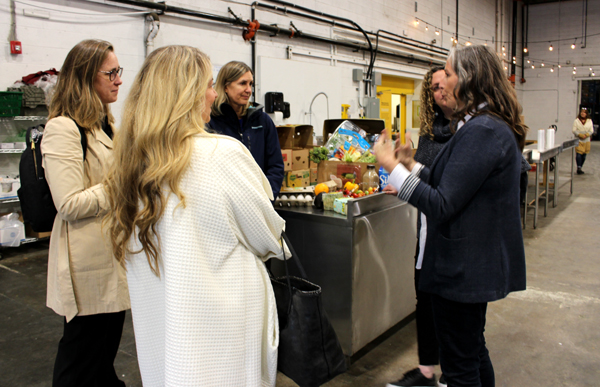

TogetherBC poverty reduction:
Food security is identified as a key issue in TogetherBC, the Province’s poverty-reduction strategy. The strategy sets a path to reduce overall poverty in BC by 25% and child poverty by 50% by 2024; the 48-page TogetherBC strategy document was released in 2019.
The TogetherBC strategy has six priority action areas: making housing more affordable; supporting families, children and youth; expanding access to education and training; more opportunities, more jobs; improving affordability; and investing in social inclusion. The study also outlines how the government is studying the parameters of ‘basic income’.
Food security funding:
Since 2019, the Ministry of Social Development and Poverty Reduction has provided nearly $26 million for planning and implementing poverty-reduction and food-security initiatives in communities throughout BC, including First Nations communities.
This funding builds on $1.9 million the Province provided for the Mustard Seed Food Bank to help buy the Food Security Distribution Centre at 808 Viewfield Road to function as the Capital Region’s food hub.
The Ministry of Agriculture and Food has invested $800,000 in the Victoria Community Food Hub and more than $8 million in the 12 regional food hubs that make up the BC Food Hub Network. The hubs help small- and medium-sized businesses access shared food- and beverage-processing space and equipment to increase their production and sales while contributing to local food security.
Farmers in the loop:
The South Island Farm Hub is growing and always open for new farmers to get involved. Local farmers are assisted in various ways, including guidance on product pricing and achieving the product quality for various markets.
The processing kitchen at the Food Security Distribution Centre is one destination for farmers to process extra supply or abundance of produce at certain times. Farmers can come in to the hub to process their product. This is an expanding service at the Food Security Distribution Centre.
Farms in our region are all shapes and sizes. Farms can start small, under two acres in size. The majority of farms are 10 acres in this region, with some that reach 50 acres in size.
Small plot intensive farming is a starting point as ‘stepping stone farms’. They likely focus on growing greens and mixed vegetables. Farmers are learning and intensifying their production. They build up a client base and then look for more land in order to grow larger amounts. A lot can be produced on even one to two acres; most incubator farms in this region are that size.
Sanddown Centre (in North Saanich) and Haliburton Farm (in the Cadboro Bay area) are two community farms with farm incubation programs for entrepreneurs. There’s land, training and skill support, as well as marketing support; it’s a way to try out farming without taking on a lot of risk.
It’s hard to get into farming and build it as a business. Barriers include the cost of buying land. These programs see ‘midlife changers’ — people who have well-developed business skills but want to do something more meaningful.
===== LINKS:
- New food hubs to strengthen food security on the Island (BC Government / March 2, 2021)
- Funding helps strengthen food security in Greater Victoria (May 12, 2022)
- Victoria Community Food Hub
- Island Food Hubs – Capital Region
===== ABOUT ISLAND SOCIAL TRENDS:
Island Social Trends has been publishing socioeconomic news insights since 2008 (first as MapleLine Magazine 2008-2010, then Sooke Voice News 2011-2013, then West Shore Voice News 2014-2020), launching fully online at islandsocialtrends.ca in mid-2020.
Founding editor and publisher for that entire series of publications is Mary P Brooke, B.Sc., Cert PR. She holds the McGeachy Prize in Journalism from the English Department at the University of Saskatchewan.
In the early part of her career, Ms Brooke led a six-month federal ‘Food Talk’ community nutrition education project, with a focus on providing information to low-income immigrant urban communities in Toronto. She also wrote pre-natal nutrition documentation for nurses and community.



